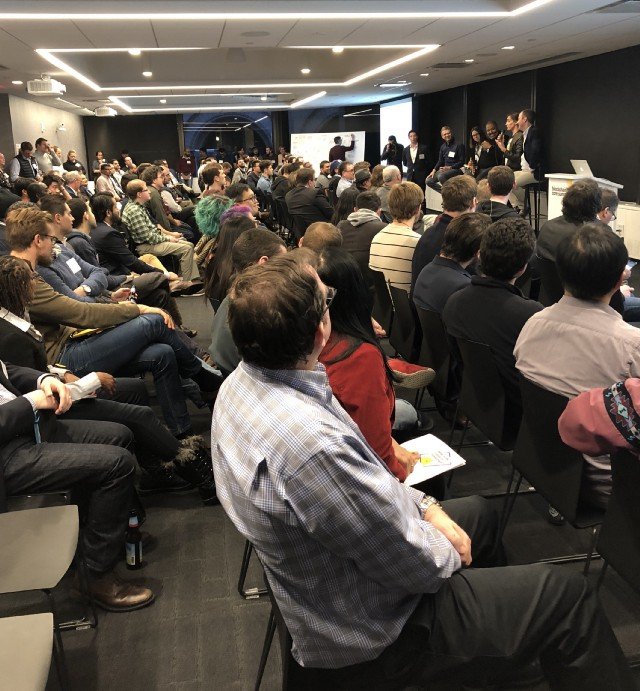What I Learned After Attending 15 Blockchain Events
It is not about commerce and many engineers disagree about the uniqueness of blockchain technology.

Underscore.VC Blockchain Core Summit — March 22, 2018 — Boston
Wow. Blockchain is everywhere.
With twenty years of experience in enterprise software but a blockchain newbie, I attended fifteen events in the Boston area (four different full-day conferences at MIT and venture capital firms and presentations at MIT, Harvard, and different Meetups) to educate myself about blockchain applications. Crypto trading was not my focus. Here is what I learned.
Blockchain is the “Wild, Wild West” and driven by passionate believers
Most attendees are really, really excited, and every blockchain conference is sold out. This amped excitement is driven by the many crypto millionaires, the millions of dollars raised by start-ups with Initial Coin Offerings (ICOs), and a strong aversion to the power of dominant vendors and governments. Over two thousand start-ups raised $7B through ICOs without giving up equity or control. Some estimate that most of these are now inactive and regulatory agencies have stepped in, but start-up funding continues at a rapid pace.
This movement is about trading and new applications, not commerce
Bitcoin and blockchain are not about online selling. I naively asked many attendees what they had purchased using Bitcoin, and only one person had ever purchased anything using the cryptocurrency. None of the paid conferences offered an option to pay using Bitcoin. In fact, the number of online merchants accepting Bitcoin has declined in the past year.
Blockchain technology is incredibly new and raw
Most of the non-crypto trading applications are built using Ethereum, the leading blockchain application tool. This technology is currently very slow, with high transaction costs, and a very cumbersome user experience (private keys and browser wallet plugins). Many people are working to improve this, but improvements won’t come for at least twelve to eighteen months. At launch, a simple game called CryptoKitties used 15% of the Ethereum network, which caused some transactions to take thirty hours to complete.
Blockchain is innovation at the data layer only
Blockchain does not bring new customer value to the user experience or the physical device (laptop or mobile phone). Blockchain applications are built with a proprietary web application that interacts with the blockchain for censorship-proof, easily audited data storage.
Very few people can explain the uniqueness of blockchain technology
This was the most surprising finding. The technical community has expressed strong skepticism about the uniqueness of blockchain for non-trading applications (Kai Stinchcombe’s two articles (in December and April) and Clemens Vasters’ post are critical of blockchain and have gone mainly unchallenged). I found many passionate believers on the business side but much fewer on the technical side.
Consumer apps are a great way to learn but are not yet compelling
Currently, no killer blockchain application outside of crypto trading exists. I tried several of the consumer blockchain apps that are live, including Peepeth (Twitter-like microblogging), CryptoKitties (digital cat game), LBRY (“blockchain for YouTube”), Graphite (work processing), and Dock.io (“blockchain for Linkedin”). These early applications are a great way to learn and kudos to the early teams for their work. In exchange for the benefit of immutable data transactions, every user transaction has an actual cost (I paid three to eight cents for each post with Peepeth), and it takes four to ten minutes to update the public blockchain. Over time, the user experience and speed will improve, but the per transaction fees likely will not.
Larger companies are piloting private blockchain applications
Some larger companies, such as Walmart and JP Morgan, are testing private blockchain for supply chain and intercompany applications. While some of these private applications are promising, questions about the unique benefits of blockchain technology persist.
Overall, I found that the reality did not meet all the hype, but the benefits of censorship-proof features and data storage among participants with low trust is worth more experimentation. I plan to continue to monitor this area as an “intrigued skeptic.”
Paul Baier has twenty years of enterprise software experience at four venture-backed companies. He earned an MBA at Harvard Business School and graduated from Kenyon College. He is not associated with any blockchain company and owns less than $1,000 of BTC.
In the business world, the rearview mirror is always clearer than the windshield.